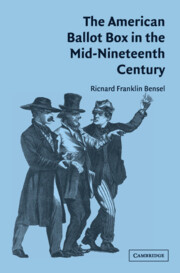Book contents
- Frontmatter
- Contents
- Preface
- Chapter 1 Introduction
- Chapter 2 Structure and Practice of Elections
- Chapter 3 Social Construction of Identity in Eastern Rural Communities
- Chapter 4 Ethno-Cultural Stereotypes and Voting in Large Cities
- Chapter 5 Frontier Democracy
- Chapter 6 Loyalty Oaths, Troops, and Elections during the Civil War
- Chapter 7 Conclusion
- Index
Chapter 2 - Structure and Practice of Elections
Published online by Cambridge University Press: 10 November 2009
- Frontmatter
- Contents
- Preface
- Chapter 1 Introduction
- Chapter 2 Structure and Practice of Elections
- Chapter 3 Social Construction of Identity in Eastern Rural Communities
- Chapter 4 Ethno-Cultural Stereotypes and Voting in Large Cities
- Chapter 5 Frontier Democracy
- Chapter 6 Loyalty Oaths, Troops, and Elections during the Civil War
- Chapter 7 Conclusion
- Index
Summary
The physical arrangement and design of ballot boxes, voting windows, and party tickets would have been recognizable to American voters throughout the nation. These material elements of the election process gave rise to practices that influenced the formation of individual voting decisions and shaped the way in which those decisions became registered as formal votes. Here we examine how these practices and the structure of voting were exploited by party agents as they sought to turn the process to personal and partisan advantage.
Election practice emerged out of the interaction between, on the one hand, the degree of familiarity between party agents and voters and, on the other, the formal requirements for voting set down in election law. With respect to the latter, the Constitution of the State of Virginia stipulated:
Every white male citizen of the commonwealth, of the age of twenty-one years, who has been a resident of the state for two years, and of the county, city or town where he offers to vote for twelve months next preceding an election – and no other person - shall be qualified to vote for members of the general assembly and all officers elective by the people: but no person in the military, naval or marine service of the United States shall be deemed a resident of this state, by reason of being stationed therein. And no person shall have the right to vote, who is of unsound mind, or a pauper, or a non-commissioned officer, soldier, seaman or marine in the service of the United States, or who has been convicted of bribery in an election, or of any infamous offence.
- Type
- Chapter
- Information
- The American Ballot Box in the Mid-Nineteenth Century , pp. 26 - 85Publisher: Cambridge University PressPrint publication year: 2004



